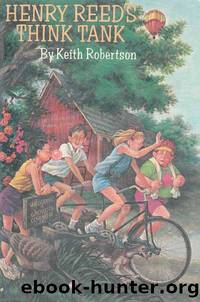Henry Reedâs Think Tank by Keith Robertson

Author:Keith Robertson
Language: eng
Format: epub
Thursday, August 29
The weather was great today. The sun was shining and there was a nice breeze. It was much too beautiful a day to stay inside, but I decided business had to come before pleasure. I wanted to know a lot more about swans before our think tank made any recommendations to Mrs. Walcott.
Uncle Al and Aunt Mabel read quite a bit, and they have more books than most people do. One whole wall of their living room is covered with books, many of them about wildlife, especially birds. I got out every book having anything to do with birds, the unabridged dictionary, and the one-volume encyclopedia. I went through them all very carefully, which didnât take long. There wasnât much about swans. About all I learned was that they are fairly close relatives to geese, only bigger.
About nine Aunt Mabel decided to go to Princeton to do some shopping, so I went along and went to the library. I did much better there. It seems North America has two native swansâthe trumpeter swan and the whistling swan. The trumpeter swan is the biggest and toughest. It lives mostly in the western United States and Canada. It chases everythingâgeese, smaller swans, and even a lot of small animals away from its nest and later away from the cygnets or baby swans. All swans can make very loud noises, because of their long necks. I guess the long neck works like those long Alpine horns which you can hear for miles. The trumpeter swan was in danger of extinction a while back, but is now making a comeback. The whistling swan is a bit smaller than the trumpeter and its call is higher pitched and has a whistling sound to it. It can be pretty noisy. It nests in the Arctic and winters on both the Atlantic and Pacific coasts. You can see swans now and then in the bird refuge areas in New Jersey and Delaware. Both trumpeter and whistling swans are pure white.
Europe and Asia have a whooping swan, which is almost as big as the North American trumpeter swan. It is becoming quite scarce. Europe also has what is called the âmute swan,â which, as Mr. Allwood said, is the one you usually see on ponds in parks. It isnât really mute at all. It can and does make some noise during nesting season if anything gets too close to its nest. However, it is much quieter than the other swans. Most of the time it doesnât make any noise at all, which is how it got its name. There is also a black swan in Australia and a white swan with a black neck in South America, but they are very rare here, so I didnât read much about them.
The mute swan was tamed in Europe centuries ago. The domesticated swans make even less noise than their wild cousins. During nesting season they may hiss a bit and once in a while give a honk, but most of the time they really are mute.
Download
This site does not store any files on its server. We only index and link to content provided by other sites. Please contact the content providers to delete copyright contents if any and email us, we'll remove relevant links or contents immediately.
Spellbound by Christopher Pike(198)
Werewolves Don't Go to Summer Camp by Debbie Dadey(190)
Medusa and Pegasus by Amy Hayes(183)
GHOSTBUSTERS II (Yearling) by B.B. Hiller(164)
Meddling Mooli and the BlueLegged Alien by Asha Nehemiah(160)
Skulduggery Pleasant - the Complete Series Books 1-9 by Landy Derek(158)
The Berenstain Bears' Perfect Fishing Spot by Stan Berenstain(150)
Princesses Save the World by Savannah Guthrie; Allison Oppenheim(145)
Winter by Steven Schnur(143)
See Inside a Castle by R. J. Unstead(141)
WANDA WEIRD by Rebecca Winch(140)
365 Tales From Indian Mythology by Om Books Editorial Team(136)
Disney Zombies: Welcome to Seabrook by Bonnie Steele(133)
The Teen Witches' Guide to Spells by Xanna Eve Chown(132)
I Want My Mum! by Tony Ross(131)
117 Days by Ruth First(131)
The Mystery of the Two-Toed Pigeon by Marc Brandel(127)
Ghostbusters II by B. B. Hiller(126)
The Quest of Quinton by Brandon Keilen(123)
